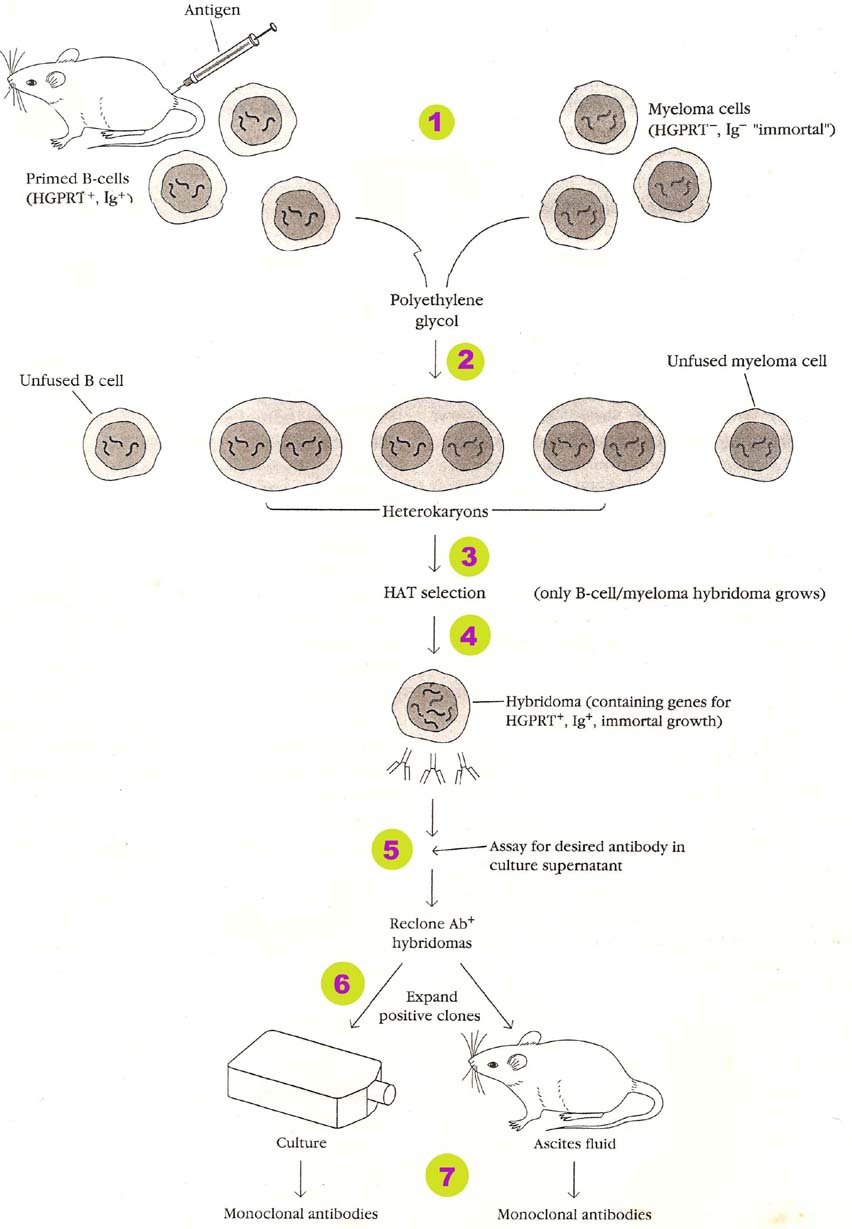Antibody production for experimental use
general and practical informations about antibody production
Hybridoma technology
Hybridoma technology
MONOCLONAL ANTIBODY PRODUCTION BY HYBRIDOMA TECHNOLGY:
Monoclonal antibodies produced in the following steps:
- Preparation of Cells
- Fusion of cells
- Selection of Hybridoma cells
- Culturing of selected hybridoma cells
- Screening of culture for antibody production
- Propagation of screened colony
- Isolation of antibodies
1. Preparation of Cells:
For the production of monoclonal antibodies, cells should be properly prepared. B cell and myeloma cells are used for monoclonal antibody production. Genetic machinery of B cells should be modified as Ig+, HGPRT--- and TK+. This is achieved through site directed mutagenesis process. These B cells are actually isolated from mice to which antigen of our interest is injected and it also posses the ability of producing antibody against antigen of our interest. Genetic machinery of myeloma cells are modified as Ig---, HGPRT+ and TK---. The reason for genetic modification is to provide antibody producing ability to B cells and for selecting hybrid cell from the culture after hybridization. Myeloma cells are used to provide immortality property.
2. Fusion of Cells:
After preparing B cell and myeloma cell, they are fused with the help of sendaivirus or polyethylene glycol (PEG). These fusogens fuse the cells to produce fused B cells-myeloma cells, cybrid and hybrids. Some unfused cells may also present in the medium.
3. Selection of Hybrid cells:
After fusing the cells with the help of fusogens they are placed in a culture medium with selection medium of HAT. Aminopterin inhibits de novo nucleotide biosynthesis. When de novo synthesis inhibited cells can use salvage pathway to produce nucleotides for that they require HGPRT and TK. Since one of this enzyme is absent in B cells, myeloma cells and cybrids, they are unable to survive in the selection medium. Those hybrid cells which are having functional HGPRT and TK are found to be capable of growing in selection medium. It can be otherwise called as that they are selected in selection.

4. Culturing of selected hybridoma cells:
After hybridoma cells are selected, they are cultured in microtiter wells in such a way that each well consists of single hybridoma cells. So that, mono clone is produced i.e. Group of cells derived from single hybridoma cells.
5. Screening cells for antibody production:
Eventhough hybridoma cells survived in the selection medium and they also form clones, there ability to form antibody is not tested yet. This property is tested using ELISA or RIA tests. Those clones which have the ability to produce antibody of our interest are allowed for next step of monoclonal antibody production.
6. Propagation of screened clones:
It is nothing but culturing or allowing selected clone cells to grow in invitro or invivo conditions respectively. In invitro technique clone cells are cultured in tissue culture flask with suitable medium. The production rate is found to be 10 – 100micrograms per ml. In invivo method, selected clones are injected into the peritoneal cavity of histocompatible mice and allowed to multiply and produce antibody. The rate of antibody production is 25 milligram per ml.
7. Isolation of antibodies:
In either of above methods, samples are collected and from these monoclonal antibodies are separated by affinity chromatography and they are used for different studies.
